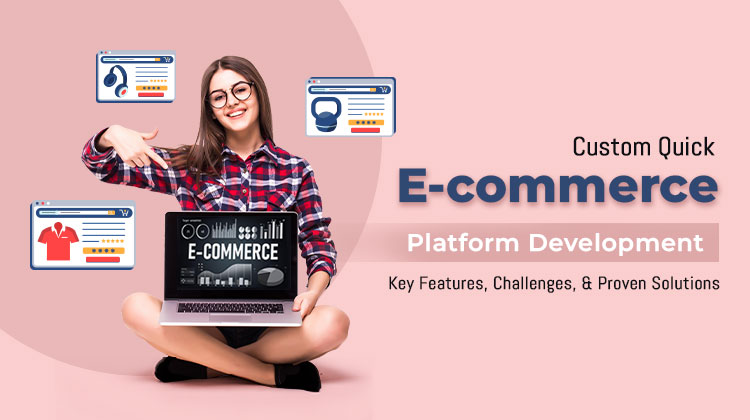
17 Mar, 2025
The rise of quick commerce (Q-commerce) has revolutionized the eCommerce industry, with reports suggesting that the global Q-commerce market is expected to grow at a CAGR of over 17% in the next five years. Consumers now expect deliveries in minutes, making speed and efficiency critical factors for success. Consumers now expect groceries, pharmaceuticals, and daily essentials to be delivered within minutes rather than days. With giants like Blinkit, Zepto, and Instamart redefining quick commerce in India, businesses must adapt to remain competitive.
A custom quick commerce platform development requires a robust infrastructure, seamless inventory management, and real-time delivery optimization. This guide will help you understand the key features, challenges, and solutions to creating a successful quick ecommerce website that meets modern customer expectations.
Essential Features of a Quick Commerce Platform
1. AI-Powered Order Management System
AI-driven order management streamlines real-time allocation, routing, and prioritization of orders. For example, leading platforms like Zepto use AI to assign deliveries within seconds, reducing overall fulfillment time. A quick commerce platform must process high volumes of orders efficiently. An AI-driven order management system ensures real-time order allocation, prioritization, and routing for faster fulfillment.
2. Hyperlocal Inventory and Warehouse Management
Managing a q commerce business requires hyperlocal inventory placement. By distributing products across strategically placed micro-fulfillment centers, businesses can reduce delivery times and stock shortages.
3. Real-Time Delivery Tracking and Optimization
Successful Q-commerce companies like Blinkit rely on real-time tracking to improve transparency and reduce delivery time. By using AI-powered route optimization, they ensure drivers take the shortest possible routes, cutting delays and operational costs. Consumers expect instant updates on their orders. A real-time GPS-enabled tracking system enhances transparency while dynamic route optimization helps reduce delivery times and costs.
4. Seamless Payment Integration
A smooth checkout process with multiple payment options, including digital wallets, UPI, and BNPL (Buy Now, Pay Later), enhances the shopping experience on a quick ecommerce website.
5. AI-Powered Personalized Recommendations
Utilizing AI to analyze shopping behaviors allows quick commerce platforms to provide tailored product recommendations, increasing customer retention and boosting sales.
6. Scalability and Cloud Integration
For sustained growth, a Q commerce platform should be built on a cloud-based infrastructure. This ensures scalability, high availability, and seamless performance under peak traffic.
7. Robust Security Measures
Given the sensitivity of payment and user data, implementing end-to-end encryption, multi-factor authentication, and fraud detection mechanisms is critical.
Challenges in Building a Quick Commerce Platform
Building a Q commerce platform is not just about fast deliveries; it requires overcoming logistical, operational, and technological hurdles. Addressing these challenges strategically is crucial for long-term success.
1. Managing Logistics and Delivery Speed
The biggest challenge in q commerce is ensuring ultra-fast deliveries while maintaining cost efficiency. Addressing this requires automated dispatching, optimal route planning, and real-time coordination with delivery partners.
2. Inventory and Demand Forecasting
Balancing supply and demand is crucial for a quick ecommerce website. Advanced AI algorithms and predictive analytics help in stock replenishment, reducing wastage and maximizing sales.
3. High Operational Costs
Setting up multiple warehouses and hiring delivery fleets can be expensive. Partnering with third-party logistics (3PL) providers and optimizing delivery routes can help reduce costs.
4. Customer Expectations and Retention
Studies show that 60% of Q-commerce users switch platforms due to inconsistent service. Businesses need a strong focus on reliability, personalized promotions, and a seamless user experience to retain customers. Consumers demand reliability, consistency, and convenience. A well-optimized Q commerce platform should ensure seamless UI/UX, personalized promotions, and instant customer support to enhance retention.
5. Integration with Third-Party Services
Seamless integration with payment gateways, CRM, and AI-based analytics tools is essential to ensure smooth platform operations and a frictionless customer journey.
Solutions for Overcoming Quick Commerce Challenges
1. Implementing Automated Warehousing
Adopting automated storage and retrieval systems (AS/RS) can improve warehouse efficiency, ensuring quick order fulfillment and minimal errors.
2. AI-Based Demand Forecasting
Leveraging AI-driven insights helps businesses predict customer demand, optimize inventory, and prevent stock shortages or overstocking.
3. Optimized Last-Mile Delivery
Using route optimization tools and real-time tracking ensures cost-effective, timely deliveries, reducing the burden on logistics partners.
4. Personalized Customer Experience
A quick ecommerce website should use data analytics to offer tailored promotions, personalized product recommendations, and loyalty rewards.
5. Cloud-Native Architecture for Scalability
A cloud-based infrastructure enables quick commerce platforms to scale dynamically, ensuring stability during peak demand.
Conclusion: Build a Scalable Quick Commerce Platform with Expert Development
The success of a Q commerce platform lies in speed, efficiency, and customer satisfaction. Companies like Zepto and Blinkit have set high industry standards by leveraging AI-driven logistics, seamless inventory management, and optimized delivery networks. Businesses must adopt these practices to stay ahead.
If you’re looking for a reliable eCommerce Website Development Company in Kolkata, Idiosys Tech is your best option. We specialise in building scalable, high-performance quick commerce platforms tailored to your business needs. Get in touch with us today to create a cutting-edge q commerce solution that drives instant sales and customer satisfaction.
If you’re also exploring the idea of launching a multi-vendor e-commerce marketplace alongside your Q-commerce solution, don’t miss our guide on developing a successful e-commerce platform tailored for marketplace models.
__________________________________________________
How does quick commerce differ from traditional eCommerce?
Quick commerce focuses on delivering orders within minutes, while traditional eCommerce typically offers delivery within days.
What industries benefit from quick commerce?
Industries like groceries, pharmaceuticals, electronics, and personal care products benefit the most from quick commerce.
How important is real-time tracking for quick commerce?
Real-time tracking enhances transparency, boosts customer trust, and enables better logistics management.
How can businesses ensure data security in quick commerce platforms?
Implementing end-to-end encryption, multi-factor authentication, and compliance with data protection regulations.
__________________________________________________
You May Also Read
The Important Role of Mobile Optimization for E-commerce Websites in 2024

